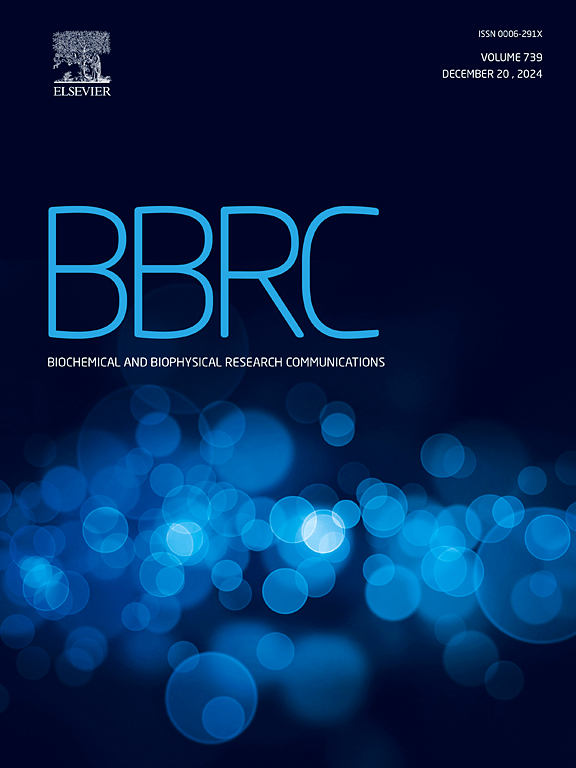Modulation of NF-κB/NLRP3 inflammasome axis Nrf2/HO-1 signaling and attenuation of oxidative stress mediate the protective effect of ambroxol against cyclophosphamide cardiotoxicity
IF 2.5
3区 生物学
Q3 BIOCHEMISTRY & MOLECULAR BIOLOGY
Biochemical and biophysical research communications
Pub Date : 2025-06-21
DOI:10.1016/j.bbrc.2025.152242
引用次数: 0
Abstract
Despite its potent chemotherapeutic efficacy, cyclophosphamide (CP) is associated with severe cardiac complications, limiting its clinical utility. Recent evidence suggests that the mucolytic agent ambroxol (ABX) exhibits antioxidant and anti-inflammatory properties, making it a candidate for mitigating CP cardiotoxicity. This study explored the protective effects of ABX against CP-mediated cardiotoxicity, with emphasis on oxidative stress, NF-κB/NLRP3 inflamamsome axis and Nrf2/HO-1 signaling. Rats were administered ABX (20 mg/kg) for 7 days and received a single injection of CP (100 mg/kg) on day 5, and blood and heart samples were collected for analyses. CP administration induced significant cardiac dysfunction, marked by elevated LDH, CK-MB, and troponin-I, alongside histopathological evidence of myocardial injury. ABX alleviated cardiac biomarkers, prevented histopathological alterations, reduced lipid peroxidation, and restored antioxidant defenses. CP upregulated NF-κB p65, NLRP3, ASC1, caspase-1, gasdermin D, and IL-1β, and suppressed Nrf2 and HO-1 in the heart of rats. ABX suppressed the NF-κB/NLRP3 inflamamsome axis mediators and upregulated Nrf2 and HO-1. In silico data revealed the binding affinity of ABX towards NF-κB p65 and NLRP3 and ASC1 PYD domains. In conclusion, ABX confers significant protection against CP-induced cardiotoxicity through multifaceted mechanisms, including attenuation of oxidative stress, inhibition of NF-κB/NLRP3 inflamamsome axis, and upregulation of Nrf2/HO-1 signaling. These findings suggest that ABX could serve as an effective adjunct therapy to improve the safety profile of CP in clinical oncology.
调节NF-κB/NLRP3炎症小体轴Nrf2/HO-1信号和氧化应激的衰减介导氨溴索对环磷酰胺心脏毒性的保护作用
尽管环磷酰胺(CP)具有强大的化疗疗效,但它与严重的心脏并发症有关,限制了其临床应用。最近的证据表明,黏液溶解剂氨溴索(ABX)具有抗氧化和抗炎特性,使其成为减轻CP心脏毒性的候选药物。本研究探讨了ABX对cp介导的心脏毒性的保护作用,重点关注氧化应激、NF-κB/NLRP3炎症轴和Nrf2/HO-1信号通路。大鼠连续7天给予ABX (20 mg/kg),第5天单次注射CP (100 mg/kg),采集血液和心脏样本进行分析。CP给药引起明显的心功能障碍,以LDH、CK-MB和肌钙蛋白- i升高为标志,同时伴有心肌损伤的组织病理学证据。ABX减轻心脏生物标志物,防止组织病理学改变,减少脂质过氧化,恢复抗氧化防御。CP上调大鼠心脏NF-κB p65、NLRP3、ASC1、caspase-1、gasdermin D、IL-1β,抑制Nrf2、HO-1。ABX抑制NF-κB/NLRP3炎性轴介质,上调Nrf2和HO-1。计算机数据显示ABX与NF-κB p65、NLRP3和ASC1 PYD结构域的结合亲和力。综上所述,ABX通过多种机制对cp诱导的心脏毒性具有显著的保护作用,包括降低氧化应激,抑制NF-κB/NLRP3炎症轴,上调Nrf2/HO-1信号。这些发现表明,ABX可以作为一种有效的辅助治疗来提高CP在临床肿瘤学中的安全性。
本文章由计算机程序翻译,如有差异,请以英文原文为准。
求助全文
约1分钟内获得全文
求助全文
来源期刊
CiteScore
6.10
自引率
0.00%
发文量
1400
审稿时长
14 days
期刊介绍:
Biochemical and Biophysical Research Communications is the premier international journal devoted to the very rapid dissemination of timely and significant experimental results in diverse fields of biological research. The development of the "Breakthroughs and Views" section brings the minireview format to the journal, and issues often contain collections of special interest manuscripts. BBRC is published weekly (52 issues/year).Research Areas now include: Biochemistry; biophysics; cell biology; developmental biology; immunology
; molecular biology; neurobiology; plant biology and proteomics

 求助内容:
求助内容: 应助结果提醒方式:
应助结果提醒方式:


